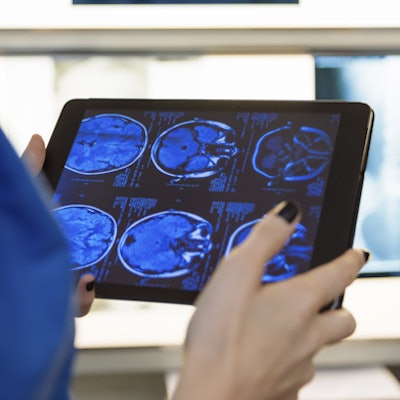
Orthopedic surgeons can significantly improve their workflow by using an iPad for mobile image access, performing consultations on challenging cases with colleagues, and communicating imaging findings to patients, German researchers reported recently in a paper published online in the Journal of Digital Imaging (JDI).
After equipping 10 orthopedic surgeons with an iPad mini 2 and mobile image viewing software, the German research team found the surgeons frequently used the tablets and were able to access images in half the time needed on a standard workstation. What's more, the surgeons particularly appreciated the tablet's ability to show images to patients.
"Tablet computers can play a vital role for image access and communication in the daily routine of an orthopedic surgeon," wrote the team led by first author Dr. Sven Vetter and senior author Dr. Jochen Franke, both of BG Trauma Center Ludwigshafen in Ludwigshafen, Germany. "Mobile image access is an important aspect for surgeons, especially in larger facilities, to facilitate and accelerate the clinical workflows."
Barriers to access
While medical images are essential in modern traumatology and orthopedic surgery, surgeons may find it cumbersome to access images due to a limited number of available workstations. Surgeons also have less time to review images and communicate with colleagues due to the sharp increase in the volume of images being generated, according to the researchers.
"Due to the sheer number of images and the lack of adequate tools, the time for reviewing radiological images has become less -- not just for diagnostic reporting, but also for surgical preparation, for example," the authors wrote. "Moreover, the images are seldom shared with colleagues or other experts for a second opinion."
As a result, the group sought to investigate the effect of tablets on image review and communication as well as workflow efficiency in the daily routine of surgeons. They provided 10 orthopedic surgeons -- six residents and four senior physicians -- with an iPad mini 2, which has the size and shape to fit into a clinician's white coat.
The iPad was equipped with mRay image viewing software (mbits imaging), a mobile app that's independent from the institution's PACS software and enables users to also instantly share images, annotated key image slices, and messages with their colleagues. Surgeons can search for images directly from the iPad or send images from the workstation to the tablet, according to the authors (JDI, 10 August 2017).
After receiving initial software training, the surgeons were told to use the device and software according to their own needs and interest. Over a nine-month period, they evaluated the software using online questionnaires on the iPad.
Frequent use
Over the course of the study, the surgeons reviewed an estimated mean of 17 imaging studies each day using a standard PC and an estimated mean of 7.1 images per day on the tablet. The ratio of image types (x-ray, MRI, and CT) viewed on the PC and the tablet were nearly the same, according to the researchers.
"Nearly one out of three images viewed, reviewed, or communicated via the mobile software demonstrated its added value as felt and expressed by the participants," the authors wrote. "This total number gives a good overall judgment on the acceptance and the benefits of this new approach and met our expectations."
The tablets were used approximately 1.1 times per day for bedside demonstration of findings, and the surgeons emphasized the tablet's benefits for showing images to their patients, the researchers noted.
The surgeons also received a total of 425 requests -- an estimated mean daily frequency of 1.7 times per day -- for a second opinion by a colleague on a patient dataset. Of these requests, a tablet was used to access images and provide a second opinion in approximately 29% of the cases.
The researchers noted, however, the software's ability to securely share annotated key images or a whole image series with colleagues was utilized only by a few participants.
"This could be because making a phone call is simply quicker," the authors wrote. "Although a collaborative communication platform is a nonblocking approach for information exchange, the fact that it is an entirely new workflow might be why our study participants neglected to use it."
Faster image access
The estimated mean time for opening a patient image was 2.2 minutes on a regular PC, compared with approximately 1 minute on the tablet. A linear mixed-effects analysis model found the mean difference was 1.1 minutes, a statistically significant improvement. The researchers noted, however, these figures relied on participant estimates, which raises the potential for bias.
"Nevertheless, the numbers confirm the expectation that a mobile device can provide quicker access to clinical data and that this is also true for complex data like radiological images," the authors wrote.
In other findings, the researchers reported images needed to be reviewed instead on a PC for better visibility in just 0.2% of the cases. Participants also reported several issues with the WiFi connection; stable and center-wide WiFi access continues to be an obstacle when implementing mobile technology, according to the researchers.
The authors acknowledged a number of limitations of their research, including its limited study design, reliance on data from questionnaires, and its single-site nature. They now plan to extend adoption of the tablets and mobile image viewing app to more departments and external physicians. In addition, future investigations should incorporate a review of how age and sex influence general acceptance of mobile devices, according to the researchers.
They concluded, however, that mobile technology offers high potential in the field of trauma surgery and orthopedics.
"Clinical orthopedic workflows and daily work of orthopedic surgeons will definitely benefit from these developments in terms of convenience, speed of decision making, and efficiency," the authors wrote.


















